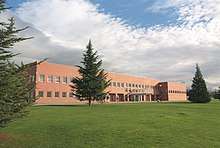University of Navarra School of Law
The University of Navarra School of Law[1] is the oldest school of the University of Navarra system. The School of Law is located on the University's Main Campus in Pamplona, Spain. Approximately 70% of its Law Students come from the other regions of Spain and from a long list of countries such as The United States, Colombia, the United Kingdom, Honduras, México, France, Albania, Jamaica, and Portugal, amongst others.

The School of Law offers an ample range of Degrees at both the undergraduate and graduate level. The Degree in Spanish Law, "Licenciatura de Derecho", is complemented by six specialization diplomas: "Derecho Económico"; "Derecho Medioambiental"; "Derecho Foral Navarro"; the Anglo-American Common Law system; as well as, Global Law (Anglo-American Law Program, International Business Law Program, Global Lawyer Certificate).
History
The School of Law was created in 1952. Lectures were initially held in the "Cámara de Comptos de Navarra" (a historic building where the Old Kingdom of Navarra's Treasury Chamber was located), and later, in the building of the Museum of Navarra. When the University's Campus was first constructed in 1963, the School of Law operated from the University's Central Building. The current School of Law Building was inaugurated in 1992. A new construction project is currently underway to build a large academic center to house the combined disciplines of Law and Economics.
Studies
Law Degree
- Standard Degree: 240 crs. ECTS.
- Standard Degree with a specialization diploma (240 + 24 crs. ECTS).
- Derecho Económico.
- Derecho Ambiental y Urbanístico.
- Derecho de Navarra.
- Anglo-American Law Program (in collaboration with the Gertrude Ryan Foundation).
- International Business Law Program.
- Global Lawyer Certificate.
- Double Degrees.
- Law+Economics: 491 crs.
- Law+Business Administration: 482 crs.
Postgraduate
- Masters Degrees.
- Corporate Law: 60 crs. ECTS.
- Tax Law: 60 crs. ECTS.
- Double master's degree.
- Master Iberoamericano de Estudios Juridicos.
- Doctorate Program: approx. 3–5 years.
Additional information
Statistics
- 152 lecturers, one of the best ratios lecturer/student in Spain (5,16 approx.)
- More than 460 undergraduate LLB students and 325 undergraduate students are currently enrolled in our Double-Degree in Law and Economics
- 50 Postgraduate students
- 11% of the university's undergraduate students and 30% of postgraduate students come from outside of Spain.
Rankings
- The school has consistently been ranked one of the top five legal institutions in Spain by QS University rankings, Times Higher Education, and the ranking El mundo.
Notable alumni
- Arancha González Laya (Spanish Minister of Foreign Affairs)[4]
- Emilio Cuatrecasas (Senior Partner)[5]
- Pedro Morenés (Spanish Ambassador to the United States)[6]
- Jesus Cardenal (Former Spanish Attorney General)
References
- "Facultad de Derecho. Universidad de Navarra". Unav.es. Retrieved 2013-08-08.
- http://www.topuniversities.com/worlduniversityrankings/results/2007/overall_rankings/top_400_universities/
- "Welcome. School of Law. University of Navarra". Unav.es. Archived from the original on 2013-02-13. Retrieved 2013-08-08.
- https://en.wikipedia.org/wiki/Arancha_González_Laya. Missing or empty
|title=(help) - "Cuatrecasas.com". Cuatrecasas.com. Archived from the original on 2013-08-07. Retrieved 2013-08-08.
- https://en.wikipedia.org/wiki/Pedro_Morenés. Missing or empty
|title=(help)
